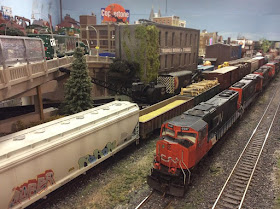Darren Davis has been posting some great photos of his layout to
the Canadian Railway Modellers group on Facebook over the past number of
months—shots of a busy double-track mainline, lots of urban and industrial action, and busy city scenes.
Seeing those photos made me wonder about his layout. How big is it? Era?
Location? Theme? I's sure others wondered about those things, too.
So I decided to ask Darren a few questions. Here’s what he told me.
When did you get started in model railroading?
I got started in 1976 with my dad, Eric, on a couple of 4 x 8
sheets of plywood. We were part of the original six members of the Burlington
modular railway club in the early 80s. This is the base of this current
layout—and we are still working on it together!
What is the name, theme of your current layout?
We call it the National Pacific. It’s a freelanced layout set in
the late 1980s to the present day where we imagine CP and CN merged.
The general theme is of heavy industry in a urban setting set in
the fictional city of Danforth, which is loosely based on the Hamilton-Toronto
area.
How big is it?
The dimensions are 33 x 12. It’s shaped like a letter “P”. There
are two 75-foot long mainlines in a figure 8 design. Part of it is hidden so it
doesn’t look like a loop.
There’s also two operating streetcars lines with dummy overhead
wire. It features automated stops.
How many industries are there?
There are over 20 online industries that can be switched,
including a 20-foot long steel mill with about 30 feet of in-plant trackage
Other main industries include a Petro Canada refinery, CBM
cement plant, Molson brewery and Inglis appliances.
How many other structures are there?
There’s about 160 structures, a mix of plastic, wood and plaster
that are either stock, kitbashed or scratchbuilt.
There’s also a diesel
servicing area with a six-stall roundhouse and two-track diesel shop with the
capacity of over 20 locomotives.
How did you do the scenery?
Scenery is a combination of plaster over wire/Styrofoam, with
ground cover.
What about your motive power and rolling stock?
There are over 110 locomotives from Athearn, Atlas, Bowser and
Rapido. They are a mix of DC and DCC. I have over 200 freight cars of various
makes and 20 passenger cars from Athearn and Rapido.
The layout seems to have a lot of vehicles on it.
It does! There are over 800 vehicles—cars, trucks and buses.
How do you operate the layout?
We don’t operate on any schedule—we just run what we want when
we want. We host two open houses a year.
Any final comments?
We like to say our layout is more of a model of a city with
trains than a conventional layout. For me, the best part about it is the time I
spend with my dad. Every year we try and add or upgrade something on the
layout.






















